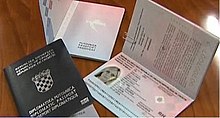Croatian passport
| Croatian passport | |
|---|---|
 The front cover of a contemporary Croatian biometric passport. | |
| Type | Passport |
| Issued by | |
| First issued | July 1, 2009 (Biometric passport) |
| Purpose | Identification |
| Eligibility | Croatian citizenship |
| Expiration | 10 or 5 years after acquisition |
A Croatian passport (Croatian: Hrvatska putovnica) is issued to citizens of the Republic of Croatia for the purpose of international travel. The passport has the purpose of serving as proof of Croatian citizenship and identity. Responsibility for their issuance lies with the Ministry of the Interior; and for citizens abroad, passports are issued by the local embassy or consulate. Croatian passports are valid for ten or five years, and are not renewable.
Croatia started issuing biometric passports on July 1, 2009
Physical Appearance
Croatian passports are dark blue, with the Croatian Coat of arms emblazoned in the centre of the front cover. The words Croatian: "REPUBLIKA HRVATSKA", English: "REPUBLIC OF CROATIA" and French: "RÉPUBLIQUE DE CROATIE" are inscribed above the coat of arms and the words Croatian: "PUTOVNICA", English: "PASSPORT" and French: "PASSEPORT" below. The passport contains 34 pages.
The Croatian passport is going to change in 2013 since its accession into the European Union on 1 July 2013. It will have a red-burgundy cover and the words "Europska Unija" (European Union in Croatian).
Languages
The data page/information page is printed in Croatian, English and French.
Data pages
From 2009, each biometric passport has a data page and a residence page. A data page has a visual zone and a machine-readable zone. The visual zone has a digitized photograph of the passport holder, data about the passport, and data about the passport holder:
|
Page No.2:
|
Page No.3:
|
History

The first Croatian passports were issued from June 26, 1991, after Croatia declared its independence from Yugoslavia. The old Yugoslav passports were valid until June 25, 1992. Since then, three types of Croatian passports have been issued, all machine-readable and with blue covers.
The first series was issued from 1991, until the end of 1999. It was distinguished by a thick paper cover and by a photo which had been laminated inside the document. This passport was printed by a local police station in the town of residence, or by the local embassy or consulate if living abroad.[citation needed] This series was in circulation until December 31, 2009, when the last ten year passport issued expired.
At the end of 1999, the Croatian Government introduced the new passport. New security features similar to those on banknotes have been added with increasing frequency since January 2000. Microprinting, holographic images, UV-visible imaging, watermarks and other details have been implemented, particularly on the photo page. As well, the photo is now digitally printed directly on the paper (in both standard and UV-reactive ink). The new passports were issued in the same way as the old ones, with a difference in printing process. All passports are printed in Zagreb, with the issuing wait time up to 30 days. They have been issued since January 1, 2000.
Biometric passport
From June 30, 2009, the government started issuing new biometric passports in Zagreb. Other local police stations started issuing biometric passports on January 18, 2010. The embassies or consulates will issue biometric passport from June 30, 2010. Non-biometric passports will remain valid until its stated date of expiry.
Croatia was the third country in Europe that started issuing second-generation biometric passports. The chip contains two fingerprints and a digital image of the passport holder.
Types of passports
- Regular Passport - blue color, valid for five or ten years.
- Diplomatic and Official Passport - for Croatian diplomats, their spouses and children. It is valid for five years.
- Temporary Passport - for citizens who work in foreign countries and need to come back into Croatia; when issued it is valid for 30 days.
Visa free travel
In January 2009 the first Assistant Secretary (acting as Under Secretary-equivalent) for Policy at the United States Department of Homeland Security Stewart Baker announced that Croatia is expected to join the Visa Waiver Program by 2013 which will make Croatian citizens eligible to travel to the United States visa-free.[1]
International travel using ID card

Croatian identity card is a valid travel document within all member states of the European Union (including the Azores, the Canary Islands and Madeira), as well as Channel Islands, Monaco, San Marino, and (by unilateral decisions of the governments of) Albania, Bosnia and Herzegovina, Macedonia, Montenegro, Serbia and Vatican City.
Once necessary amendments in legislation are made, Croatian citizens will be able to use ID card for travels to Iceland, Liechtenstein, Switzerland and Norway. [2]
Validity in these countries (except Albania, Bosnia and Herzegovina, Macedonia, Montenegro and Serbia) is based on the membership of the European Union and the implementation of the "European Agreement on Regulations governing the Movement of Persons between Member States of the Council of Europe".[3]
Gallery of historic passports
-
Passport issued from 1991-1999
-
Passport issued from 2000-2010, non-biometric
-
Croatian passport, non-biometric, first page
See also
- List of passports
- Visa requirements for Croatian citizens
- Visa policy of Croatia
- Foreign relations of Croatia
- Croatian diplomatic missions
- Croatian identity card
References
This article needs additional citations for verification. (June 2010) |



